Abraham When and Where
Mike Ervin
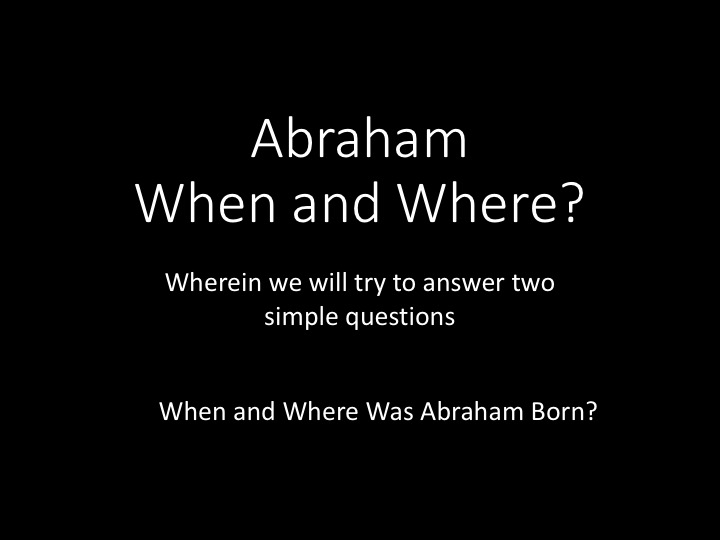
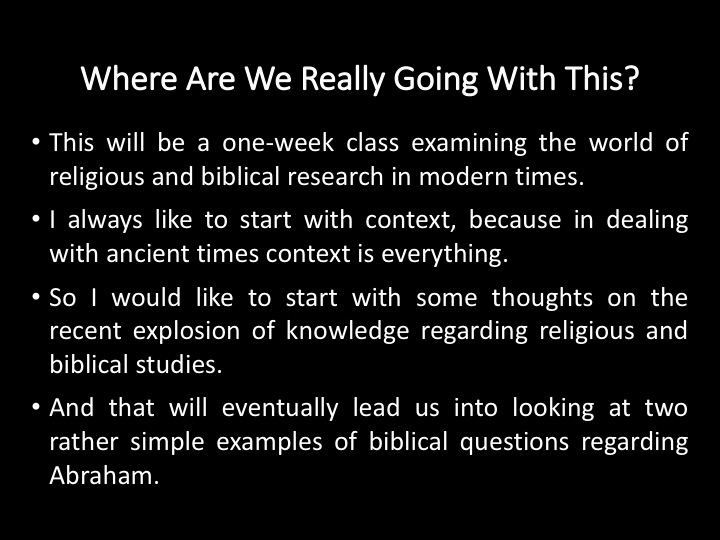
Where Are We Really Going With This?
Ok – what I would really like to do is to explore what I consider to be what is really an extraordinary explosion in religious and biblical understanding that has happened in the 20th and 21st centuries. To many of us this has been under reported because we don’t follow the academic world of religious studies. Or the academic world at all. It is too big and complex and “academic” and few of us outside of the field read “academic” journals.
I always like to start with context, because in dealing with ancient times context is everything.
So I would like to start with some thoughts on the recent explosion of knowledge regarding religious and biblical studies.
And that will eventually lead us into looking at two rather simple examples of biblical questions regarding Abraham.
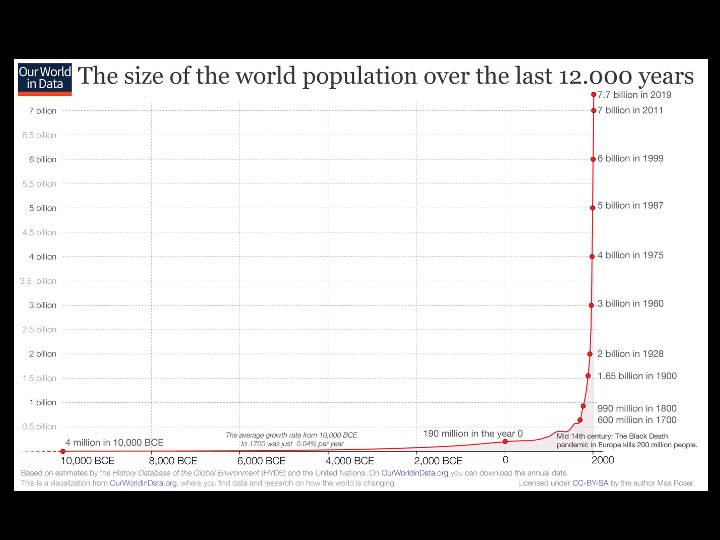
Well - you may not have expected this - but the first data I want to show you is a graph of world population. Most people know this but may not be that familiar with the magnitude of it. This type of graph is often called a hockey stick. It basically is showing us that for almost all of history nothing was happening, and then suddenly it happened! And this straight up graph at the end is the world that we were born in and have lived in. It should be a reminder to us that our assumptions about the world were formed in a very different time than the times we study in the Bible.
Note the little drop in population in the mid 14th century from the Black Death.
Roughly from about 1870 until now is the period called the Industrial Revolution. It represents the time period in which the energy required to grow economies switched from human (and animal) muscle power to abundant power sources such as fossil fuels, nuclear energy, hydroelectric power, and more recently solar and wind power.
I should also point out that biblical times are fairly recent (in this graph) and stretch from about 2000 BCE to maybe 150 of the common era.
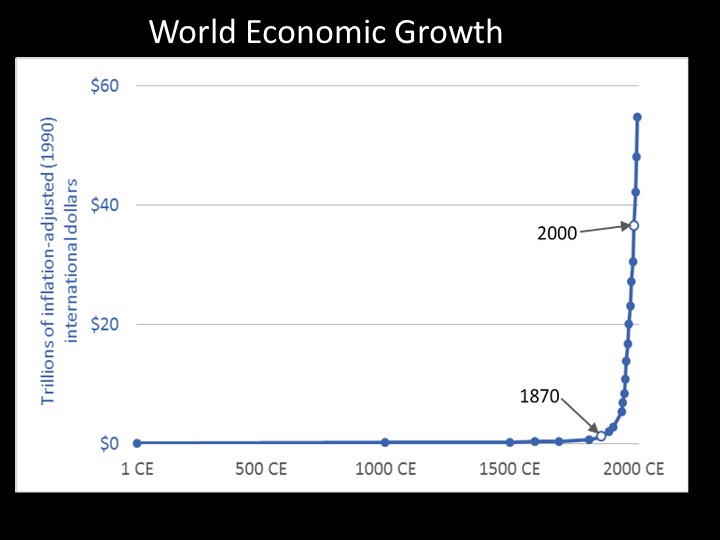
Speaking about the growth of economies, here is another hockey stick that happened in conjunction with population. This is economic growth as measured in trillions of constant 1990 dollars since the beginning of the common era. We have definitely lived in different times. And as you can well imagine this tremendous growth of both population and wealth has enabled a corresponding growth in one of the things we are discussing in today's class - an explosive growth in the 20th and 21st century of universities , seminaries, and religious and biblical research in the world.
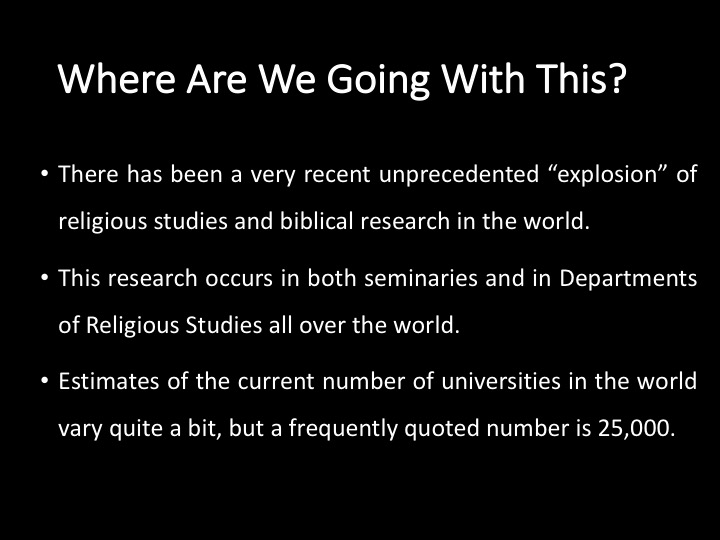
Where Are We Going With This?
There has been a very recent unprecedented “explosion” of religious studies and biblical research in the world.
This research occurs in both seminaries and in Departments of Religious Studies all over the world.
Estimates of the current number of universities in the world vary quite a bit, but a frequently quoted number is 25,000.
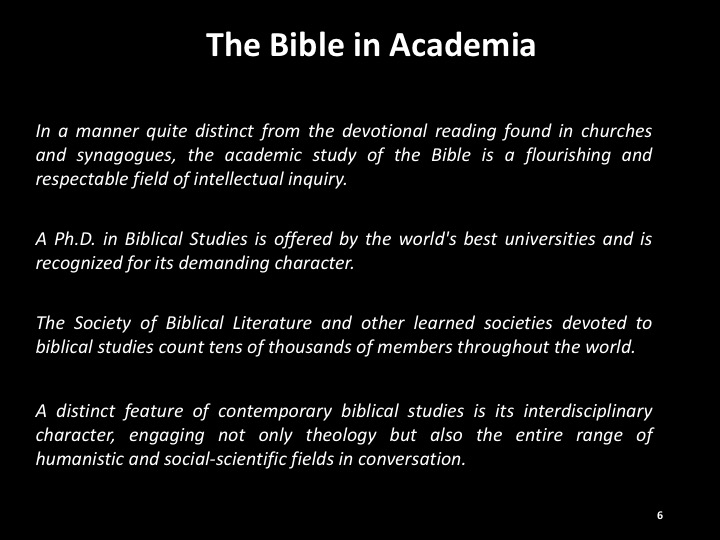
The Bible in Academia
In a manner quite distinct from the devotional reading found in churches and synagogues, the academic study of the Bible is a flourishing and respectable field of intellectual inquiry.
A Ph.D. in Biblical Studies is offered by the world's best universities and is recognized for its demanding character.
The Society of Biblical Literature and other learned societies devoted to biblical studies count tens of thousands of members throughout the world.
A distinct feature of contemporary biblical studies is its interdisciplinary character, engaging not only theology but also the entire range of humanistic and social-scientific fields in conversation.
No longer is Biblical study limited to theology.
Interestingly, this flourishing nodule of Biblical Studies continues to grow despite a growing secularization and even anti-religious bias in many universities today.
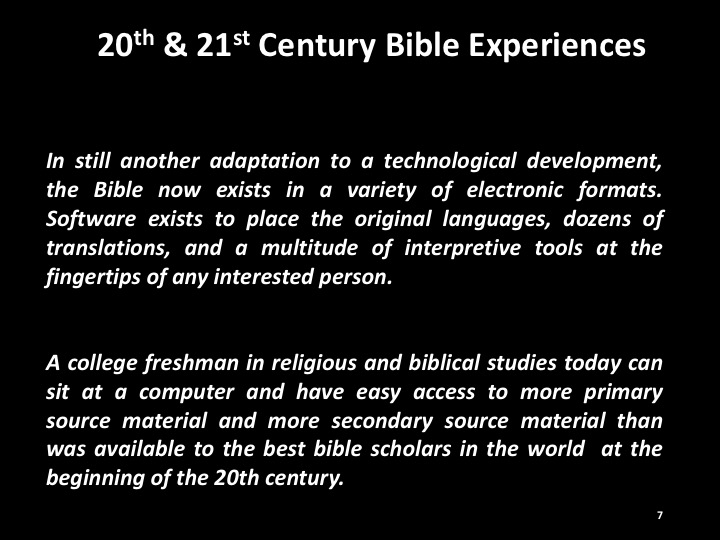
20th & 21st Century Bible Experiences
In still another adaptation to a technological development, the Bible now exists in a variety of electronic formats. Software exists to place the original languages, dozens of translations, and a multitude of interpretive tools at the fingertips of any interested person.
A college freshman today can sit at a computer and have easy access to more primary source material and more secondary source material than was available to the best bible scholars at the beginning of the 20th century.
People can "Google" into Bible blogs and participate in chat rooms with others around the world.
Many young Christian people today consider their true church not the building they attend with their parents but the chat rooms in which they talk about the Bible with their friends.
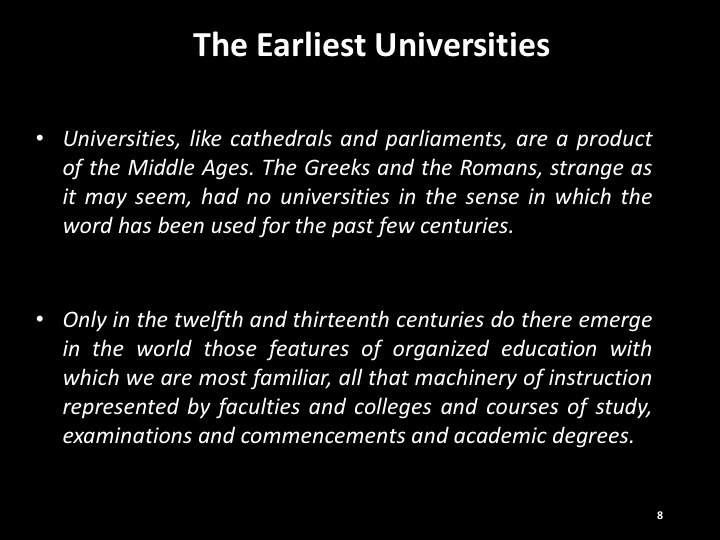
The Earliest Universities
Universities, like cathedrals and parliaments, are a product of the Middle Ages. The Greeks and the Romans, strange as it may seem, had no universities in the sense in which the word has been used for the past few centuries.
Only in the twelfth and thirteenth centuries do there emerge in the world those features of organized education with which we are most familiar, all that machinery of instruction represented by faculties and colleges and courses of study, examinations and commencements and academic degrees.
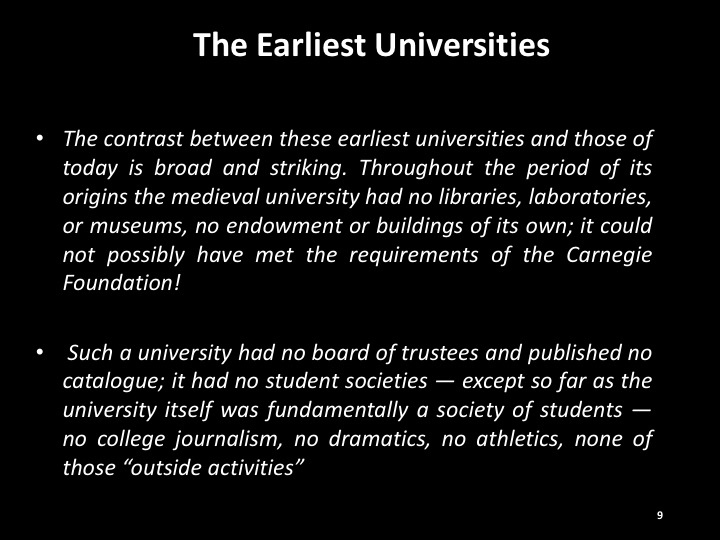
The Earliest Universities
The contrast between these earliest universities and those of today is of course broad and striking. Throughout the period of its origins the medieval university had no libraries, laboratories, or museums, no endowment or buildings of its own; it could not possibly have met the requirements of the Carnegie Foundation!
Such a university had no board of trustees and published no catalogue; it had no student societies — except so far as the university itself was fundamentally a society of students — no college journalism, no dramatics, no athletics, none of those “outside activities”
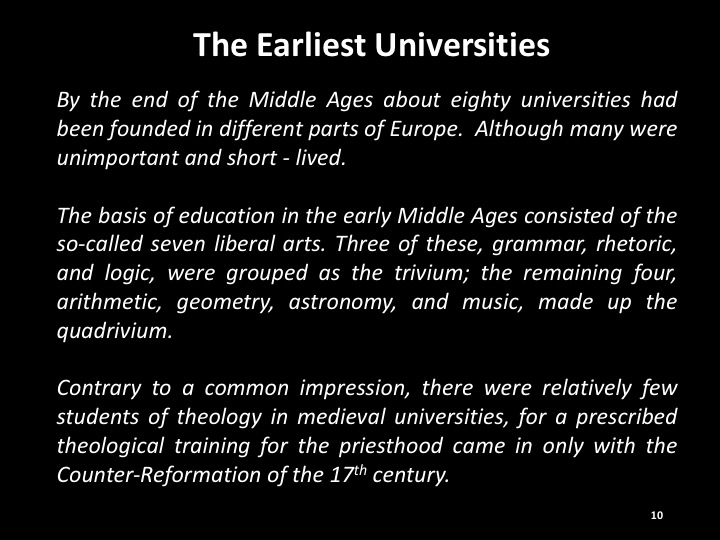
The Earliest Universities
By the end of the Middle Ages about eighty universities had been founded in different parts of Europe. Although many were unimportant and short - lived.
The basis of education in the early Middle Ages consisted, as we have seen, of the so-called seven liberal arts. Three of these, grammar, rhetoric, and logic, were grouped as the trivium; the remaining four, arithmetic, geometry, astronomy, and music, made up the quadrivium.
Contrary to a common impression, there were relatively few students of theology in medieval universities, for a prescribed theological training for the priesthood came in only with the Counter-Reformation of the 17th century.
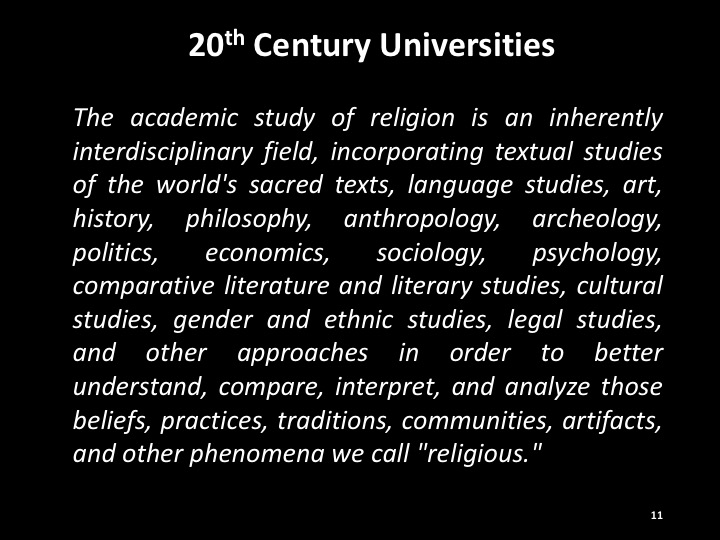
20th Century Universities
The academic study of religion is an inherently interdisciplinary field, incorporating textual studies of the world's sacred texts, language studies, art, history, philosophy, anthropology, archeology, politics, economics, sociology, psychology, comparative literature and literary studies, cultural studies, gender and ethnic studies, legal studies, and other approaches in order to better understand, compare, interpret, and analyze those beliefs, practices, traditions, communities, artifacts, and other phenomena we call "religious."
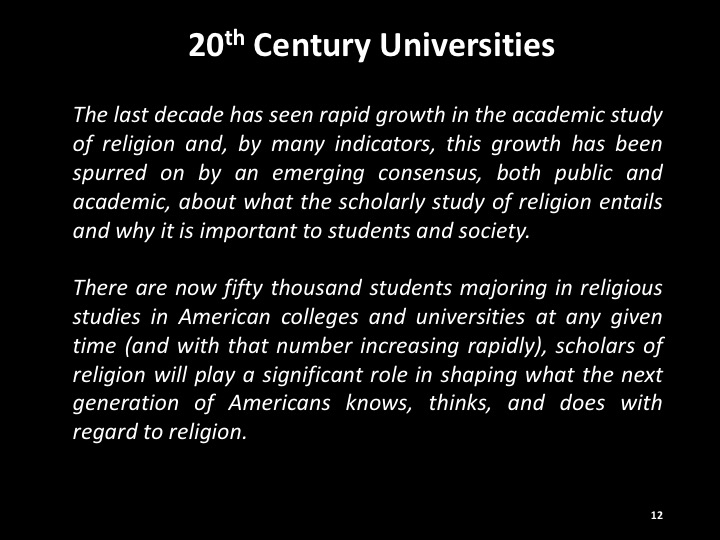
20th Century Universities
The last decade has seen rapid growth in the academic study of religion and, by many indicators, this growth has been spurred on by an emerging consensus, both public and academic, about what the scholarly study of religion entails and why it is important to students and society. With almost fifty thousand students majoring in religious studies in American colleges and universities at any given time (and with that number increasing rapidly), scholars of religion will play a significant role in shaping what the next generation of Americans knows, thinks, and does with regard to religion.
O.K. I promised some context before we addressed some questions about Abraham. So let's move on.
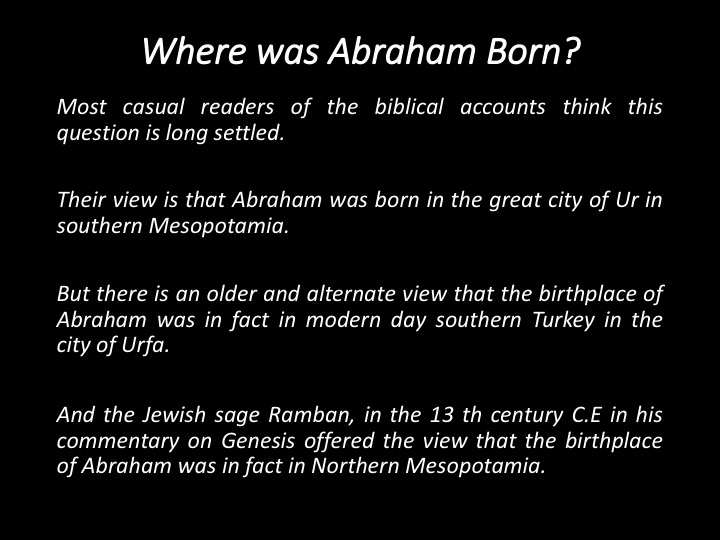
Where was Abraham Born?
Most casual readers of the biblical accounts think this question is long settled.
Their view is that Abraham was born in the great city of Ur in southern Mesopotamia.
But there is an older and alternate view that the birthplace of Abraham was in fact in modern day southern Turkey in the city of Urfa.
And the Jewish sage Ramban, in the 13 th century C.E in his commentary on Genesis offered the view that the birthplace of Abraham was in fact in Northern Mesopotamia.
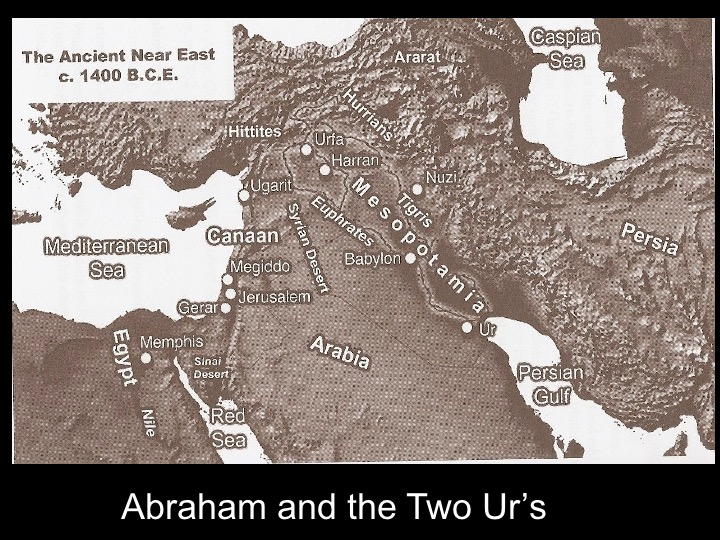
Let's look at a map. This is a map of the Ancient Near East showing the two large empires of Egypt and Mesopotamia, both powerful because they are riverine societies, and all societies before the industrial revolution were basically agrarian societies. In between them is the land of Canaan.
The two candidates that have often been debated as possible birthplaces of Abraham are the city of Ur, shown in southern Mesopotamia, and the city of Urfa, shown in far northern Mesopotamia.
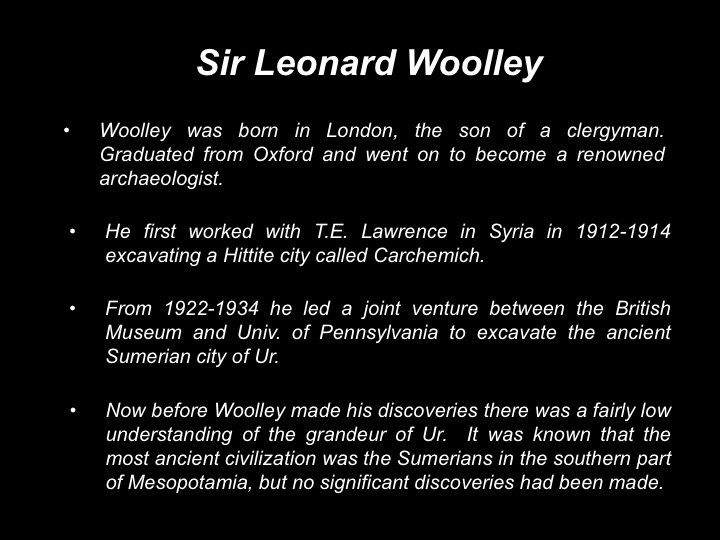
Sir Leonard Woolley
To understand this we need to meet Sir Leonard Woolley.
Woolley was born in London, the son of a clergyman. Graduated from Oxford and went on to become a renowned archaeologist.
He first worked with T.E. Lawrence in Syria in 1912-1914 excavating a Hittite city called Carchemich. In case you did not notice - T. E. Lawrence is better known as Lawrence of Arabia.
From 1922-1934 Woolley he led a joint venture between the British Museum and Univ. of Pennsylvania to excavate the ancient Sumerian city of Ur.
Now before Woolley made his discoveries there was a fairly low understanding of the grandeur of Ur. It was known that the most ancient civilization was the Sumerians in the southern part of Mesopotamia, but no significant discoveries had been made.
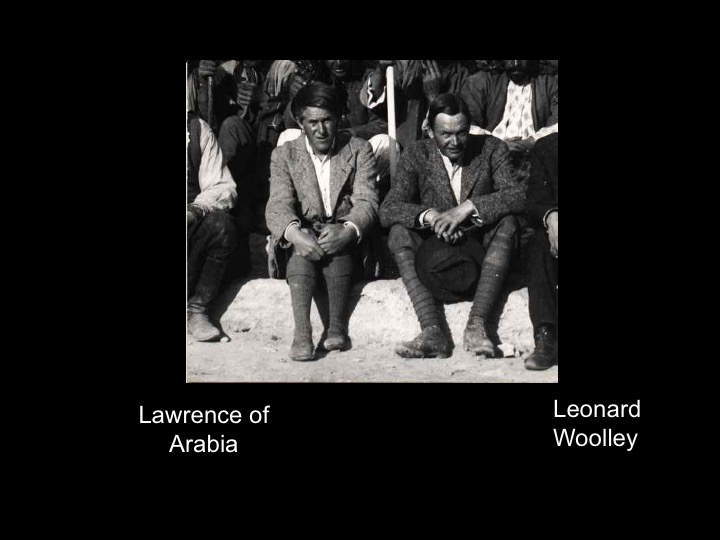
Yes - they worked together.
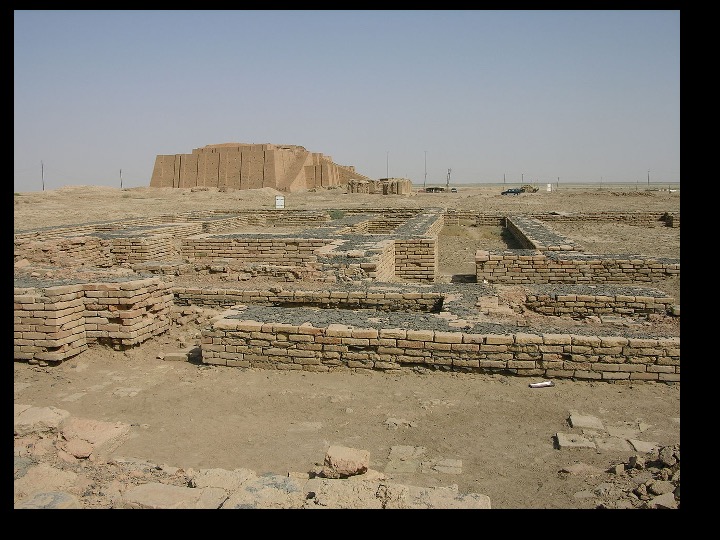
The discoveries at Ur exceeded all expectations. This photo only represents a small portion of the city. But in the background is the famous Ziggurat of Ur.
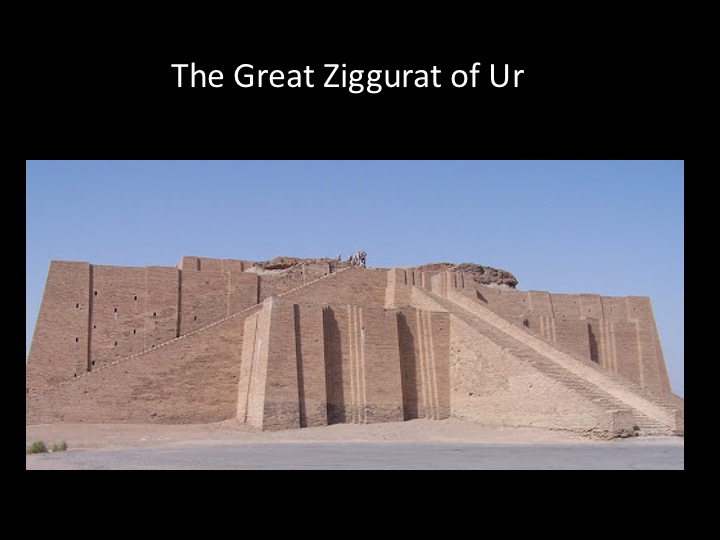
Up close it was magnificent once cleaned up and repaired. But based on cuneiform drawings they found it was clear that the original was considerably taller. It represented human attempt to build a stairway to heaven in their local religion. But let's look at an artists rendering of what it may have looked like in it's heyday.
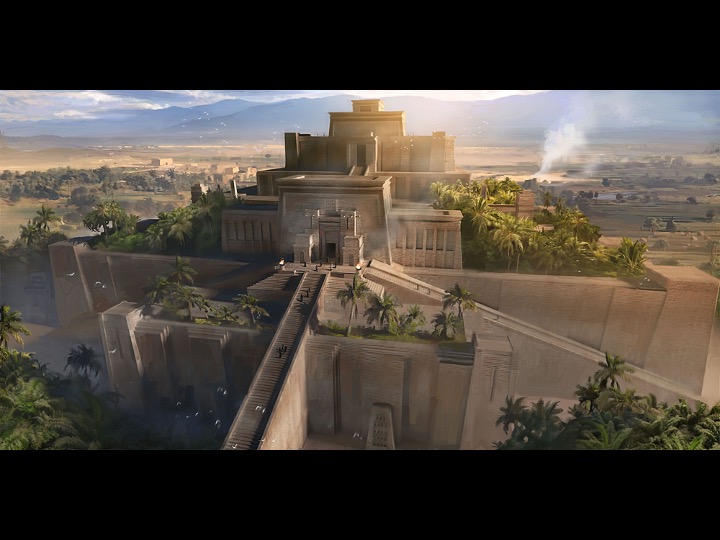
This is an artist's rendering of the completed Ziggurat surrounded by the city.
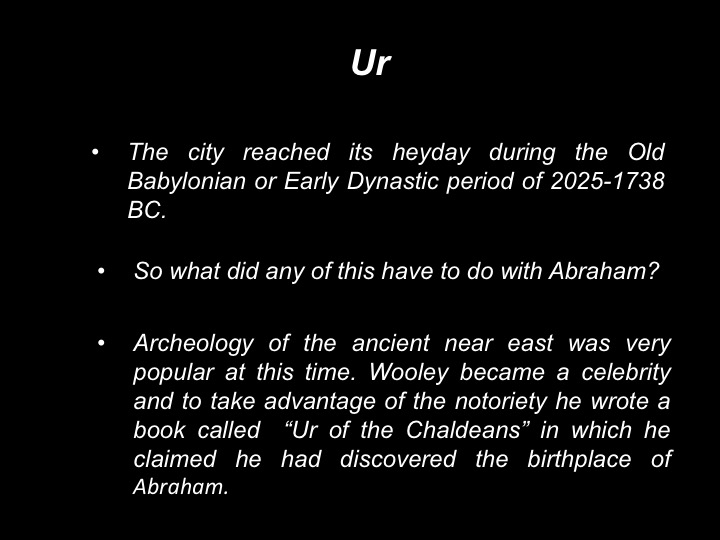
Ur
The city reached its heyday during the Old Babylonian or Early Dynastic period of 2025-1738 BC.
Four main residential areas of the city included homes with baked mud brick foundations arranged along long, narrow winding streets and alleyways. Typical houses included an open central courtyard with two or more main living rooms in which the families resided. Each house had a domestic chapel where cult structures and the family burial-vault was kept. Kitchens, stairways, workrooms, lavatories were all part of the household structures.
The houses were packed in very tightly, with exterior walls of one household immediately abutting the next one. Although the cities appear very closed off, the interior courtyards and wide streets provided light, and the close-set houses protected the exposure of the exterior walls to heating especially during the hot summers.
Important discoveries at Ur included the Royal Cemetery, where rich Early Dynastic burials were found by Woolley in the 1920s; and thousands of clay tablets impressed with cuneiform writing which describe in detail the lives and thoughts of Ur's inhabitants.
So what does any of this have to do with Abraham?
Archeology of the ancient near east was very popular at this time. Wooley became a celebrity and to take advantage of the notoriety he wrote a book called “Ur of the Chaldeans” in which he claimed he had discovered the birthplace of Abraham.
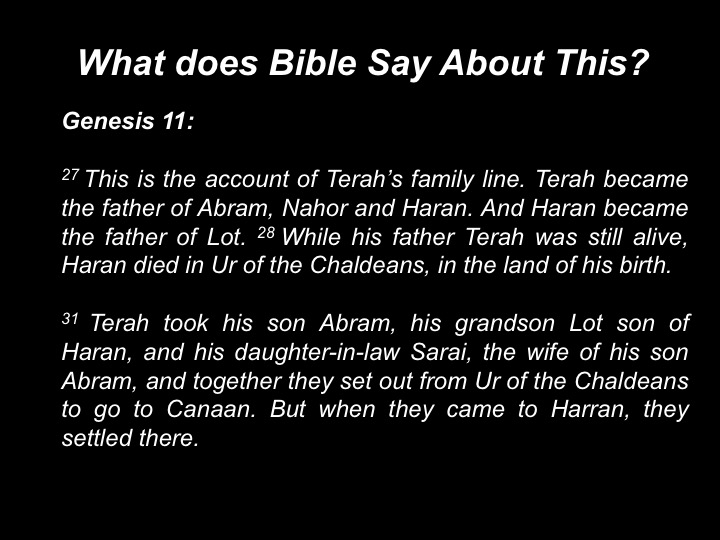
What does Bible Say About This?
Genesis 11:
27 This is the account of Terah’s family line. Terah became the father of Abram, Nahor and Haran. And Haran became the father of Lot. 28 While his father Terah was still alive, Haran died in Ur of the Chaldeans, in the land of his birth.
31 Terah took his son Abram, his grandson Lot son of Haran, and his daughter-in-law Sarai, the wife of his son Abram, and together they set out from Ur of the Chaldeans to go to Canaan. But when they came to Harran, they settled there.
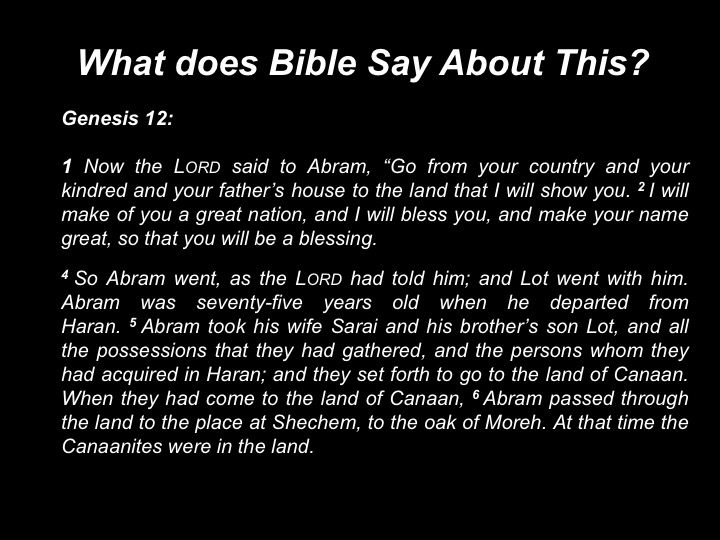
What does Bible Say About This?
Genesis 12:
1 Now the Lord said to Abram, “Go from your country and your kindred and your father’s house to the land that I will show you. 2 I will make of you a great nation, and I will bless you, and make your name great, so that you will be a blessing. 3 I will bless those who bless you, and the one who curses you I will curse; and in you all the families of the earth shall be blessed.”[a]
4 So Abram went, as the Lord had told him; and Lot went with him. Abram was seventy-five years old when he departed from Haran. 5 Abram took his wife Sarai and his brother’s son Lot, and all the possessions that they had gathered, and the persons whom they had acquired in Haran; and they set forth to go to the land of Canaan. When they had come to the land of Canaan, 6 Abram passed through the land to the place at Shechem, to the oak of Moreh. At that time the Canaanites were in the land.
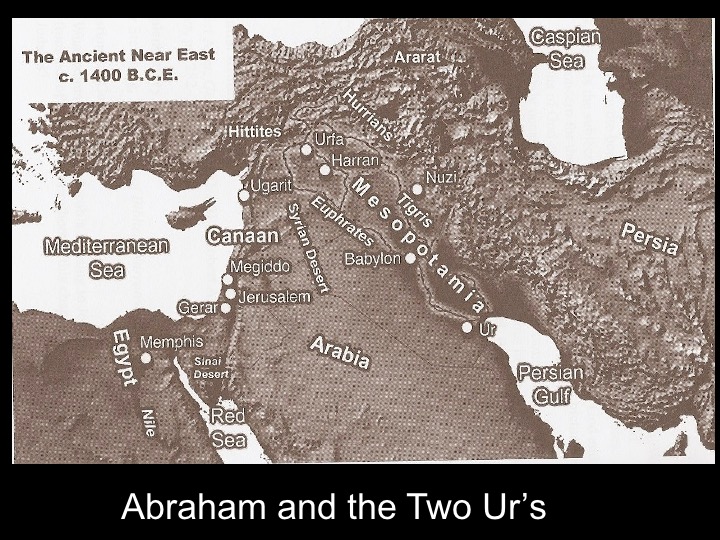
Here we are again with the map showing the two candidate cities. Note for future reference that the southern Ur is on the western side of the Euphrates but the northern one is on the far side of the Euphrates. Why might this be important? Let's look at another Biblical reference: This one in Joshua.
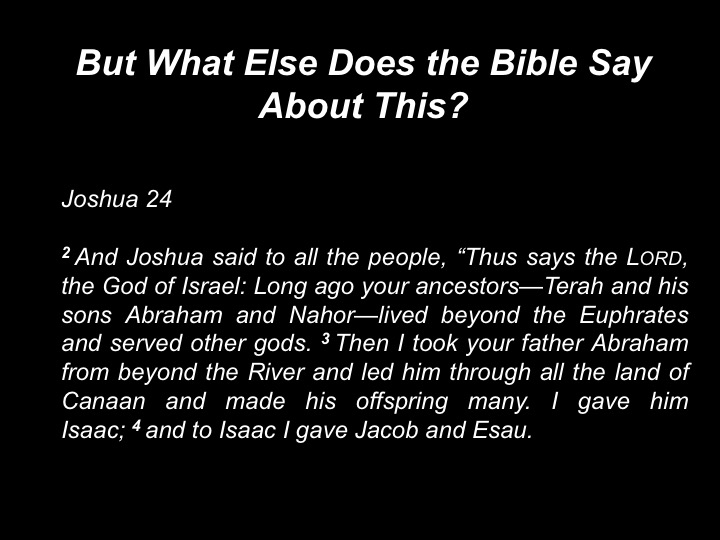
But What Else Does the Bible Say About This?
Joshua 24
2 And Joshua said to all the people, “Thus says the Lord, the God of Israel: Long ago your ancestors—Terah and his sons Abraham and Nahor—lived beyond the Euphrates and served other gods. 3 Then I took your father Abraham from beyond the River and led him through all the land of Canaan and made his offspring many. I gave him Isaac; 4 and to Isaac I gave Jacob and Esau.
Note that Joshua says that Terah and Abraham live beyond the Euphrates (east). But note on the maps shown previously that the Southern Ur was not west of the Euphrates but clearly east. Not however that Urfa was "beyond the river".
And there is a further language issue here. Does the Bible really say "Ur of the Chaldeans"? Let's investigate that.
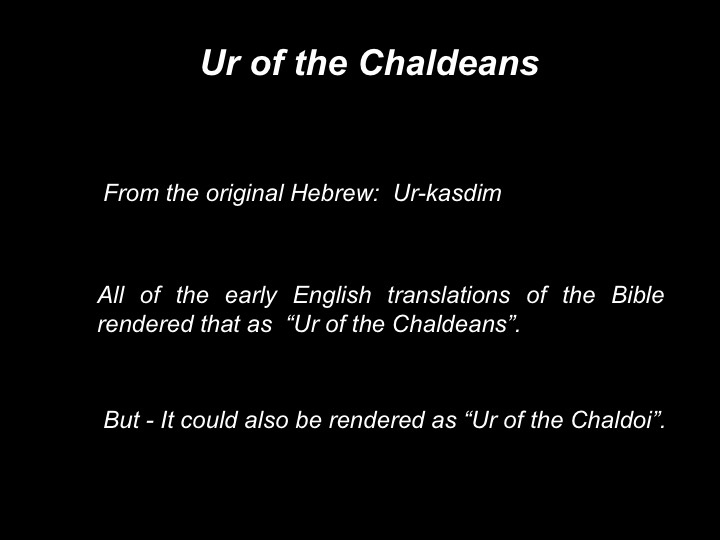
Ur of the Chaldeans
A scholarly linguistic issue arises here.
The original Hebrew text reads those verses we just saw as Ur-kasdim
And all of the early English translations (Wycliff, Tyndale, KJV, Geneva, etc.) have rendered this as either Ur of the Chaldeans or Ur of the Chaldees.
And interestingly a group of Semitic people called the Chaldeans immigrated into this part of Southern Mesopotamia – although that was not until the eighth century BC.
But linguistically this could be rendered also as the Chaldoi, and that is also a proper translation based on what we know of the language. What is the significance of that? The Chaldoi were a people that the Greek historian Xenophon identifies as neighbors of the Armenians in northern Mesopotamia. So Ur-Kasdim could be translated either way.
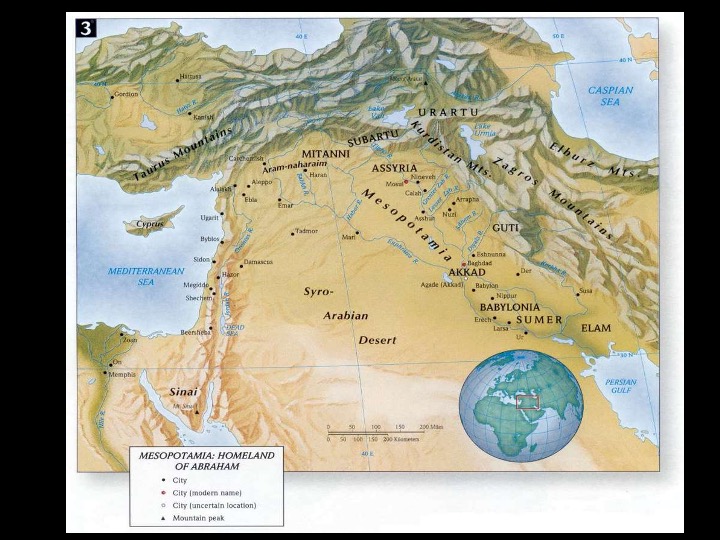
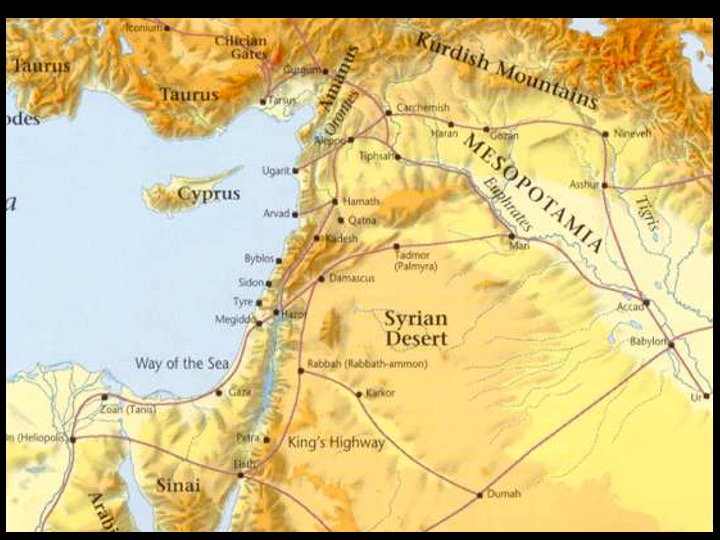
And then another issue come up when we look at a special map of the trade routes of the time. This map shows the two empires of Egypt and Mesopotamia, who were constant trading partners with goods moving in both directions.
The information that has come from ample research into this trade indicates that there was one main trade route that everyone used to move goods between these trading partners. it is called the Way of the Sea and was considered the primary safe passage. The portion of the Way of the Sea between Damascus and Mari was often called the Great Trunk Route.
The issue then becomes, if Terah was taking his family from the Ur of southern Mesopotamia with Canaan as his final destination as Genesis Chapter 11 describes - why did he ignore the shortest and safest route toward Canaan. The Way of the Sea actually passes thru part of Canaan. Instead Woolley argued that he traveled much further north until he and his family would eventually stop and settle in Haran. A still long distance from the Land of Canaan.
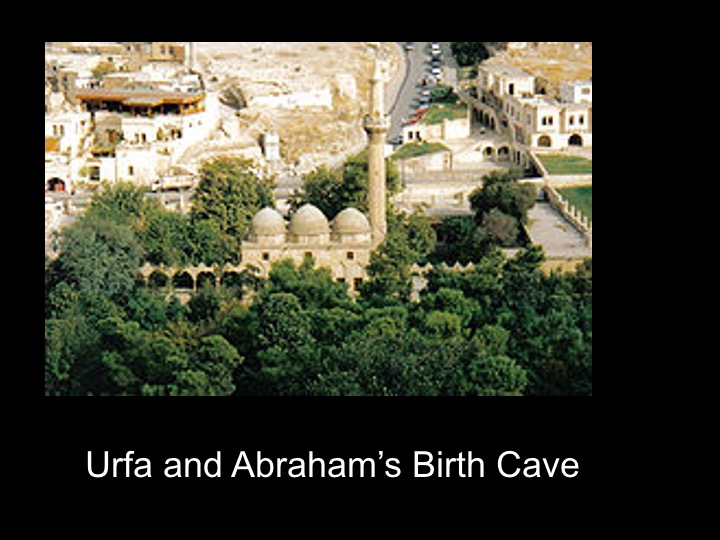
Now what about Urfa, The modern northern city of Urfa (shown in the photo) has for many years had a pilgrimage location for locals to visit the birth cave of Abraham.
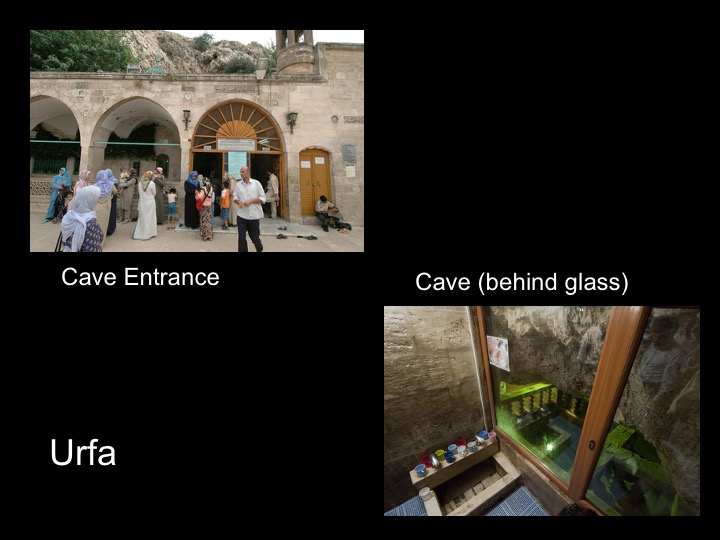
This is the entrance to the cave. Visitors from all three of the Abrahamic religions can go in and purchase post cards and other collectibles and will be shown the cave where Abraham was born. So for many the dispute over the birthplace of Abraham still goes on. We report you decide.
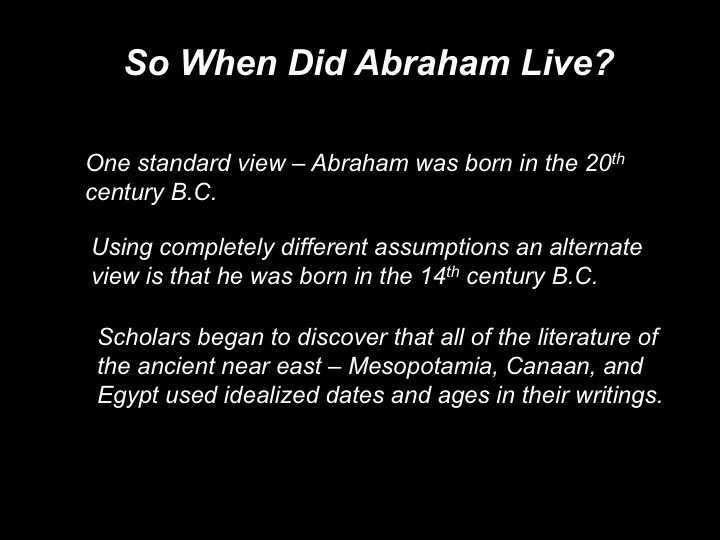
So When Did Abraham Live?
This one is a little tricky. A standard view places Abraham as early as 2000 B.C. This dating typically is based on a literal acceptance of the number of years presented in the Bible, which has come into question in the 20th century because of all of the literary discoveries of the writing style of that early period.
There is a competing view however – one based not on literal acceptance of all of the ages and time periods presented– but on the genealogical records presented in Genesis. And as it turns out that gives a completely different number. Using that approach Abraham can be dated as early as the 14th century B.C.
Again – this dating is not threatening to anyone's beliefs – but again – inquiring minds want to know – and so they argue.
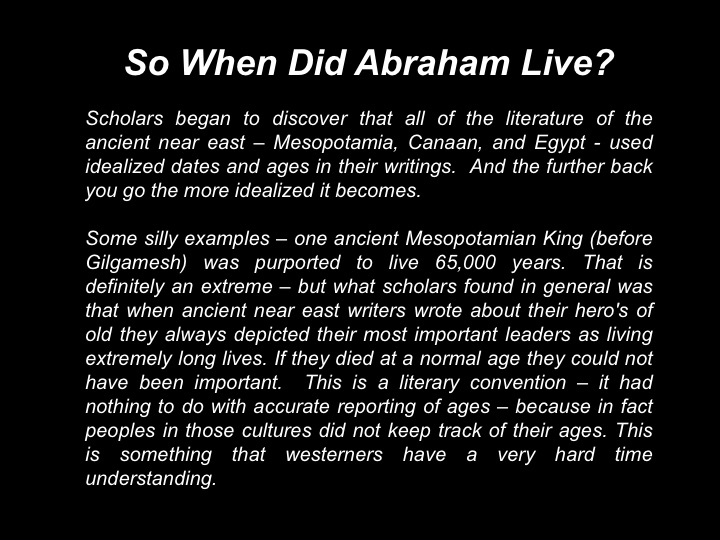
Scholars began to discover that all of the literature of the ancient near east – Mesopotamia, Canaan, and Egypt - used idealized dates and ages in their writings. And the further back you go the more idealized it becomes.
Some silly examples – one ancient Mesopotamian King (before Gilgamesh) was purported to live 65,000 years. That is definitely an extreme – but what scholars found in general was that when ancient near east writers wrote about their hero's of old they always depicted their most important leaders as living extremely long lives. If they died at a normal age they could not have been important. This is a literary convention – it had nothing to do with accurate reporting of ages – because in fact peoples in those cultures did not keep track of their ages. This is something that westerners have a very hard time understanding.
Let me illustrate by relating a story told by Cyrus Gordon– a famous early 20th century ancient near east scholar and a specialist in ancient language..
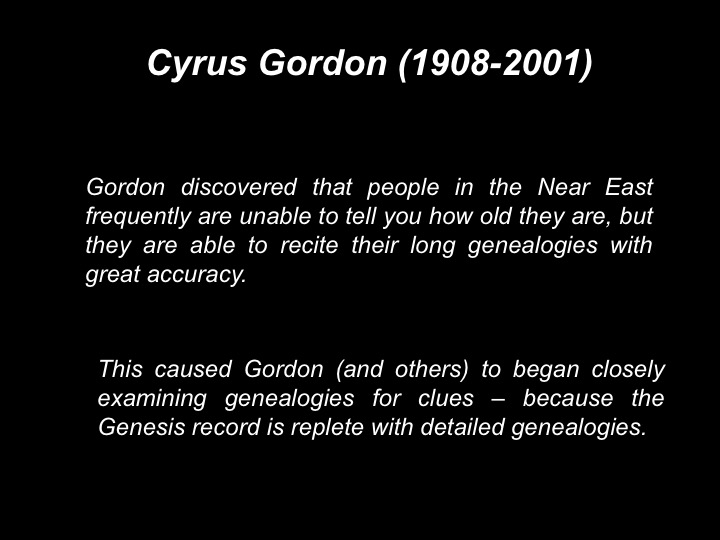
The story that Cyrus Gordon reported is as follows:
As a young scholar on his first archeological dig in the company of many senior archeologists he took notice of a young man and his son who they had hired locally to do the hard and careful work of digging up and cleaning up artifacts and he noticed how hard they worked together and particularly how diligent and smart the young boy was. So he made a point one day to join some of the workers at the daily lunch break and he began a conversation with the man. He praised his work and especially the work of his son, commenting that the man must be very proud of his son. The man was clearly pleased and agreed that his son was a very diligent worker.
Then, just to continue the conversation he asked a simple question of the man - "How old is your son?" the man immediately responded - "Only Allah knows - maybe 20, maybe 40." Gordon was rather stunned because as he told the story, the boy could not have been older than 12 years old and the man was probably in his early thirties.
So that evening at the evening meal of the assembled archeologists he repeated what the man had said and how extraordinary it was. They all started laughing. They responded to him "Didn't you know this - none of these people in these cultures have any idea of how old they are, because they do not record their date of birth and they quickly lose track of how old they might be because it is simply not important in their culture. the knowledge of birth dates and the celebration of birthdays is a western thing".
And then the archeologist suggested - "The next time you get a chance ask the same man if he knows who his ancestors are and see what he says".
So Gordon did that and first asked the man how old he was and got the immediate response "Only Allah knows - maybe 40 maybe 80." Another stunner. Then he asked the man if he knew who his ancestors were and the man immediately began listing his grandfathers, great grandfathers, great-great grandfathers and so on out to about seven generations.
And because Genesis is full of detailed genealogies Gordon began to realize that these could be a source of detailed information times in the Bible. This learning eventually caused Gordon (and others) to begin read the genealogies literally and counting generations (rather than ages).
So let us first see how we get to 2000 BC using ages:
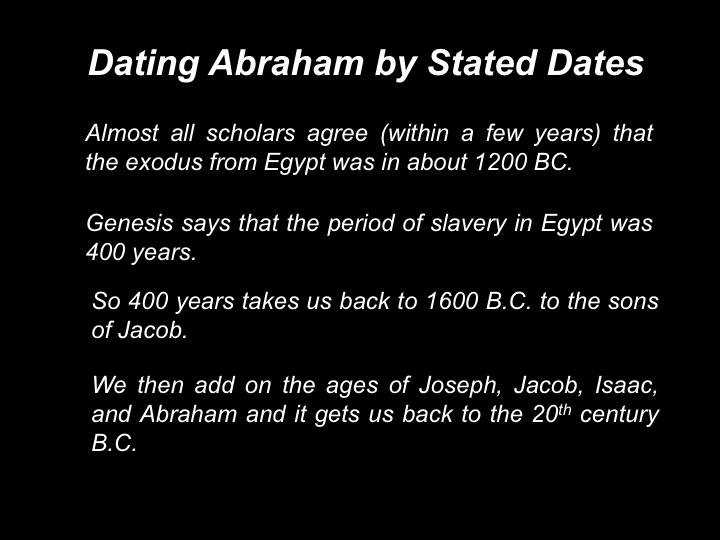
Dating Abraham by Stated Dates
So let’s talk about the two very different approaches for dating Abraham.
The math is pretty simple.
Almost all scholars agree (within a few years) that the exodus from Egypt was in about 1200 BC.
Genesis says that the period of slavery in Egypt was 400 years.
So 400 years takes us back to 1600 B.C. to the sons of Jacob.
We then add on the ages of Joseph, Jacob, Isaac, and Abraham and it gets us back to the 20th century B.C.
But what if we use geneologies and count generations instead of ages:
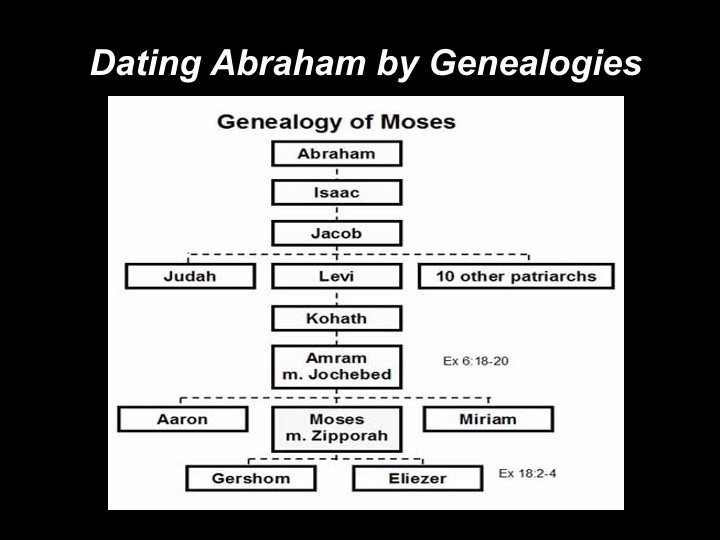
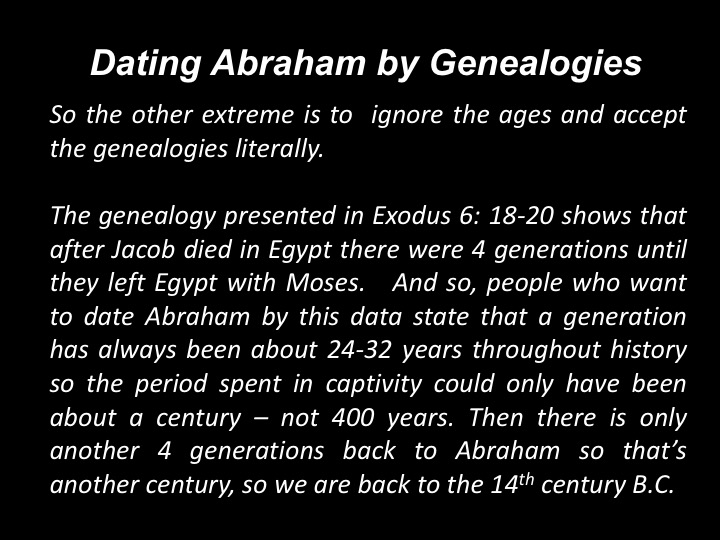
Dating Abraham by Genealogies
So the other extreme is to ignore the ages and accept the genealogies literally.
The genealogy presented in Exodus 6: 18-20 shows that after Jacob died in Egypt there were 4 generations until they left Egypt with Moses. And so people who want ot date Abraham by this data state that a generation has always been about 24-32 years throughout history so the period spent in captivity could only have been about a century – not 400 years. Then there is only another 4 generations back to Abraham so that’s another century so we are back to the 14th century B.C.
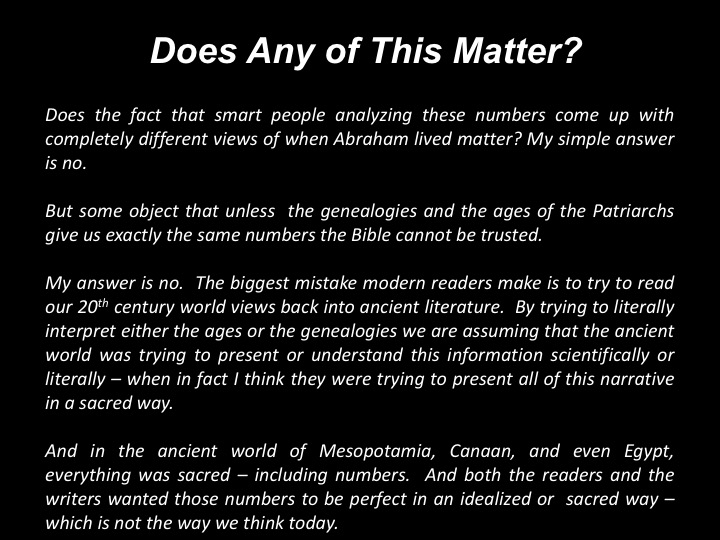
Does Any of This Matter?
Does the fact that smart people analyzing these numbers come up with completely different views of when Abraham lived matter? My simple answer is no.
But some object that unless the genealogies and the ages of the Patriarchs give us exactly the same numbers the Bible cannot be trusted.
My answer is no. The biggest mistake modern readers make is to try to read our 20th century world views back into ancient literature. By trying to literally interpret either the ages or the genealogies we are assuming that the ancient world was trying to present or understand this information scientifically or literally – when in fact I think they were trying to present all of this narrative in a sacred way.
And in the ancient world of Mesopotamia, Canaan, and even Egypt, everything was sacred – including numbers. And both the readers and the writers wanted those numbers to be perfect in an idealized or sacred way – which is not the way we think today.